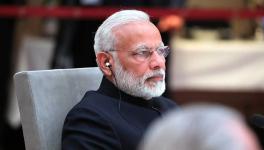100% FDI in Defence: How Wrong can you Get?
Indo US Defense Cooperation
A Golden Raspberry Award or Razzie has been awarded in Hollywood every year since 1981 to the film declared to be the worst movie of the year just a day before the Oscars. If there were a Razzie for the worst public policy in India in the recent past, it would certainly go to the Modi government’s announcement of opening up the defence manufacturing sector to 100% FDI with relaxed norms. Even as muddle-headed policies go, it cannot get worse than this, compounded by the perverse logic being advanced in favour of the new policy by the political leadership, officials of the Ministry of Defence and sections of industry.
The stated goal of the new liberalized FDI policy in general, and by extension of the defence sector in particular, was declared in the tweet from the Prime Minister’s Office (PMO) as “providing major impetus to employment and job creation in India.” However, provided they are actually created, are jobs are the only criteria? Surely, the dominant objective of the defence manufacturing sector is to enhance indigenous defence capability, build a manufacturing ecosystem of advanced technology and precision engineering, and hence build long-term self-reliance and security. But supporters of the policy, who have in fact long advocated it, believe that the policy will actually help achieve all these objectives and propel India towards becoming a global defence manufacturing and exports hub.

Image Courtesy: en.wikipedia.org
This article argues that, in fact, none of these goals are likely to be achieved, for reasons that lie in the very nature of defence technologies and at the very heart of the interests of international original equipment manufacturers (OEM). It is further argued that arguments supporting the new policy as furthering these goals are founded on three complete myths. First, that FDI has so far not come in to India because the regulations were not liberal enough, despite the evidence of outcomes following a series of increasingly liberalized norms over a decade and more. Second, that permitting 100% FDI will encourage OEMs to being in advanced technologies because they no longer need worry about loss of intellectual property rights (IPR). Third, that the expected rush of international defence majors setting up manufacturing bases in India will see a dramatic enlargement of high-tech defence manufacturing ecosystem that has hitherto eluded India, despite the seven decades of experience and capacity building in defence public sector undertakings.
New norms aid cronyism
Let us at the outset look at the supposedly further liberalized FDI norms for the defence industry and what they imply.
The previous policy of FDI in the defence sector provided for 49% FDI by the automatic route and also already permitted FDI going up to 100% after government approval, conditional upon the investment bringing in ‘state-of-the-art’ technology. Government obviously meant this as an incentive for bringing in advanced technologies. International OEMs however, who apparently take things more literally than their Indian counterparts, in their efforts to goad the Indian government to further open up the FDI policy, had been complaining about this proviso, arguing that the term ‘state of art’ is open to subjective interpretation by bureaucrats and thus does not bestow the clarity that investors desire. There were even apprehensions that this could result in post-facto witch-hunts after changes in government.
The new policy is no different, but only changes the requirement from ‘state of art’ to ‘modern’ technologies. This latter term too is just as arbitrary and open to subjective interpretations! Like all such stipulations, it equally leaves the doors open to manipulating permissions and enables persons holding important political or bureaucratic posts to play favourites and encourage cronies. One could always interpret the term modern to have greater latitude, for instance, any post World War II technology could be termed ‘modern’.
But quibbling aside, the change in terminology clearly means that India is now prepared to grant 100% FDI to an OEM to basically bring in any technology that has contemporary market value. This means that India is quite happy to host manufacturing facilities even for somewhat outdated hardware, further suggesting that the few jobs this would entail would satisfy India, never mind bringing in advanced technology into the country or promoting a manufacturing eco-system for the same.
Domestic orders main goal of OEMs
The implications became painfully obvious virtually the day after the new policy was announced when sections of the press reported that the US aircraft manufacturer Lockheed Martin was getting ready to set up an assembly line in India for its ageing F-16 fighters. Fuel had already been added to this speculative fire by earlier remarks by the increasingly voluble Defence Minister Manohar Parrikar that India was preparing to induct new fighter aircraft technologies as part of its stuttering ‘Make in India’ programme. In fact, rumours had been doing the rounds for several months, in fact ever since India suddenly, and with insufficient explanation, announced it would but only 36 Rafale aircraft from France as against the original tender for 126 as per the Air Force’s carefully worked out requirements.
It is worth recalling that, early on in the Medium Multi-Role Combat Aircraft (MMCRA) tendering process several years ago, India had rejected the F-16s for being of 1970s vintage and being designed primarily for air-to-air combat whereas India wanted an aircraft with deep strike ability, longer range and heavier weapons payload. Lockheed Martin was, however, even agreeable to set manufacturing facilities in India since the aircraft had been phased out by the USAF and the assembly line in the US was about to close down, what with overseas orders also reduced to a trickle. Boeing’s F/A-18 fighter better met India’s requirements but the Rafale and the Eurofighter were judged to be better, not only because they were more state-of-art but also because they performed much better in field trials. Despite all this and the painstaking MMRCA decision-making process, if the American aircraft are now being brought back into the picture, it must be due to some extraneous considerations such as pleasing the new ‘major defence ally,’ namely the USA, or simply the temptation of a few jobs under ‘Make in India.’
But the net effect will be an India-based F-16 production line with India being compulsorily the major buyer of the obsolescent product, especially since most other countries have now moved on to more contemporary aircraft, now characterized as ‘modern’ even if not ‘state of art’!
It is therefore not the regulation that was the main constraint for FDI earlier, but the lack of a firm Indian commitment to place orders with the concerned OEMs. The provisos are merely cosmetic. Defence hardware are not consumer durables where foreign investors are looking for a foothold and gradually expanding market share taking the risks in their stride. It should be noted that, in the past decade or so, FDI inflows in the defence sector have been a meagre $20 million, and the main reason is obvious. The OEMs want assurances that Indian orders will be forthcoming before they invest the obviously large sums required. A spokesperson for an international consultancy firm in India in fact said as much with reference to the new policy: “this decision will now bring in real investments provided the defence ministry also speeds up the procurement process and issues big ticket orders.” (emphasis added)
So is the Modi government offering up the huge Indian defence acquisition budget over the next twenty years or so to international OEMs as an incentive for them to set up shop in India? Even if this means older technology, lower defence capability?
The technology myth
In fact, there is little incentive for any international OEM to transfer or bring in the latest technology into India. Advanced technologies are the mainstay of the economic domination of the advanced capitalist countries given today’s international division of labour. Manufacturing of all kinds of goods has been shifting towards countries with lower labour costs and greater flexibility except advanced technologies and high-tech skills are involved and where lower labour costs offer no great advantage. There is not a single example of any defence hardware major setting up production lines outside their home country. India also admittedly does not offer a pool of highly skilled workers, a major block in many different sectors. In any case, most advanced countries have highly restrictive regulations governing the export of defence technologies and, conversely, on imports of defence hardware too. As would be obvious from current debates in these countries, such as in the US presidential campaign, there is much anxiety in advanced countries about high-tech jobs flowing to other countries, and protectionism is rife despite all the tall talk about free markets. The fledgling private space launch industry in the US, for instance, including such innovators as Jeff Bezos of Amazon and Elon Musk of Tesla fame, has openly cautioned the US government and NASA against commissioning launches of US satellites by ISRO, arguing that this will hurt the American industry and deprive Americans of jobs! Even if India offers 100% FDI, just because this gives the foreign OEM control of the production lines, does not mean they will bring in latest technologies and allow this know-how to filter down into the Indian manufacturing industry.
India has implemented a series of licensed manufacturing agreements for defence hardware, for instance, fighter aircraft such as the Gnats, Jaguars, Mirages and MiGs, right since Independence, and all with the idea of gradually absorbing know-how and acquiring technological capability. IPR issues never came in the way of these arrangements, suppliers simply ‘transferred’ those technologies which they wanted and kept the others close to their chests. Acquisition of capability, especially of technology development rather than merely production, takes a great deal of goal-orientation determination and effort on the part of the recipient country. For many reasons, India never succeeded in this endeavour, not least because of inadequate effort. So why should things be any different under the new policy? For example, even if Lockheed Martin were to set up an F-16 facility in India in India, it would not allow important technologies to enter the Indian industrial ecosystem. It would, simply and legitimately, import all crucial components or sub-assemblies from parent plants in the US as has been the case under licensed production hitherto!
The jobs and money myths
Finally, the ultimate justification that, despite all the above difficulties, the expected rush of investments under the new policy would create large numbers of jobs and thus hugely enrich India.
India already has an offsets policy under which international suppliers must spend 30% of the contract value in India, and 50% in the case of high-value contracts. That is a lot of money and a lot of jobs by any reckoning, and a condition that has seen OEMs moaning and groaning asking, and obtaining, all manner of concessions and exceptions from the Indian government. If an OEM sets up shop in India, would they really spend more than this amount in manufacturing from scratch in India? Or would they simply import sub-assemblies or even whole assemblies for a variety of reasons such as economies of scale at the parent plants, IPR and protection of jobs at home? In either case, it is highly doubtful if there would be a quantum jump in jobs created in India under the new policy. As for technologies flowing in, if India were really interested, it should have strategically leveraged the offsets policy to acquire and absorb specific technological capabilities so as to develop indigenous capability in the long run, thus moving towards all the goals outlined.
All measures to liberalize FDI in the defence sector, going back to the Vajpayee NDA government, UPA 1 and 2, and now the Modi government, have been introduced and justified by trotting out the same logic that it will bring in jobs and investments, enhance domestic know-how and enhance the defence manufacturing ecosystem in India. None of it has happened because, as discussed above, the reasons for foreign OEMs not bringing in contemporary technologies lie elsewhere. If India wants to acquire self-reliance capability in the defence sector, it must take the difficult road, compel the OEMs to part with technologies through the offsets route and strive hard to absorb know-how. There is no short-cut. And pressure must be mounted on the OEMs to deliver, holding out the Indian acquisitions market as the incentive.
Yet each new step of FDI liberalization is accompanied by new concessions and further justifications, perversely advancing the same arguments that international experience does not support at all and which got nowhere the previous time around! Foreign OEMs have by now concluded that, far from India using their acquisitions as leverage, are handing over the levers of pressure to the suppliers! And OEMs will only take further advantage by taking more, and giving less.
Disclaimer: The views expressed here are the author's personal views, and do not necessarily represent the views of Newsclick.
Get the latest reports & analysis with people's perspective on Protests, movements & deep analytical videos, discussions of the current affairs in your Telegram app. Subscribe to NewsClick's Telegram channel & get Real-Time updates on stories, as they get published on our website.























